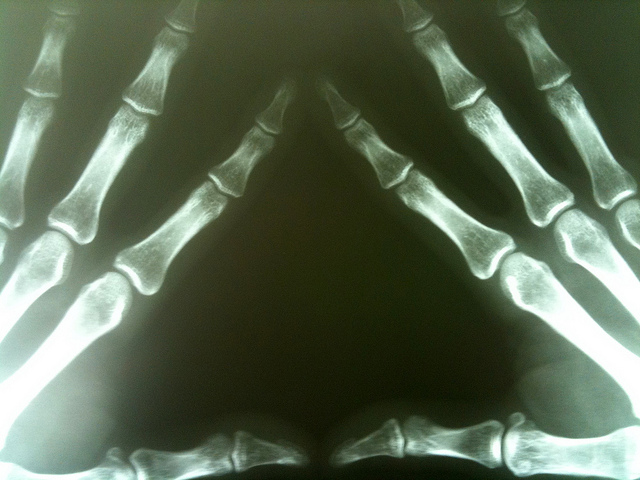Musculoskeletal diseases, defined as injuries to the soft tissues, currently affect more than one out of every two persons in the U.S. age 18 and older, and nearly
three out of four over the age of 65. Low back pain affects at least 80% of adults at some point, with an estimated annual cost of more than $100 billion. Trauma, back pain and arthritis -- the three most common musculoskeletal conditions -- are the most common reason for patient visits to physicians’ offices, emergency departments and hospitals every year. With the aging U.S. population, musculoskeletal diseases are becoming a greater burden every year.
A determination must be made if the pain generator is muscular or structural, and incorrect diagnoses can lead to inappropriate treatments and, in the worst case, unnecessary surgeries.
About 80% of healthcare and social costs related to low back pain are attributed to just 10% of patients with chronic pain and disability. This statistic suggests that improved interventions to reduce the recurrence of low back pain can underpin significant cost savings and improvement in patient outcomes.
The standard approach to managing soft tissue injuries is to obtain a medical history and perform a physical examination. Imaging or testing usually is not needed in the early phases of treatment. In most cases, the natural history of a soft tissue injury resolves without intervention.
There are excellent tools to diagnose structural abnormalities or nerve injuries. These include imaging studies, nerve condition tests and disograms. X-rays can be used to assess the possibility of fracture or dislocation. Nerve conduction studies may be used to localize nerve dysfunction.
But they are not adequate for soft tissue injury or functional assessments. MRI and CT scans, while excellent tests to evaluate structure, are generally static and not designed to assess muscle function dynamically. In addition, these standard tests all carry a high rate of false positives.
There is no magic bullet or one test that does everything. While many tests are good for what they are designed to evaluate, they are not appropriate to diagnose a soft tissue injury.
Enter electrodiagnostic functional assessment -- EFA testing. The EFA is a diagnostic tool that combines and enhances five medically accepted tests: electromyography, range of motion, functional capacity evaluation, pinch and grip strength. The EFA is non-invasive and non-loading. The advantage the EFA presents over performing these tests individually is that it performs all tests simultaneously and in a dynamic fashion.
This equipment has a 510 (k) registration with the Food and Drug Administration as a Class II diagnostic device. Furthermore, the FDA has recognized in the intended use section that the technology can distinguish between acute and chronic pathology, is able to look at referred pain patterns and is useful with treatment recommendations and baseline testing.
Physicians encounter patients daily with complaints of injuries to the soft tissues, particularly the paraspinal muscles. In many cases, objective findings are obvious, but many patients may have injuries that are subtle but continue to cause symptoms. In other cases, the injuries may be less recent, and the physical findings may not be apparent. Direct palpation of soft tissues can, in some cases, reveal the nature or type of injury, but this manner of diagnosis relies on static testing. For some individuals, problems may only be encountered during activity. Measuring muscle activity during range-of-motion testing is difficult at best. The extent to which a patient exerts herself also presents a subjective bias with soft tissue injury.
Better outcomes will be demonstrated by using the correct tools to evaluate the underlying pathology. In Adam Seidner’s paper “Assessing disease and wellness in the occupational setting: Electrodiagnostic Functional Assessment from
wired to wireless,” he demonstrated that, when the EFA was implemented as a case management tool, it enhanced the level of discussion among treating providers, injured workers and claim professionals. The study demonstrated that medical and lost wage payments to injured workers and their healthcare providers were 25% lower in the EFA group, for an average savings of $10,000 per claim versus the control group. Most importantly, the average return to work was 213 days in the EFA group versus 275 for the control group, or an average of 62 days sooner. The EFA was able to provide better diagnostic information on soft tissue injuries and return the individual back to activities of daily living sooner. Better patient care leads to better outcomes.
The EFA results are further demonstrated in the paper “Musculoskeletal disorders early diagnosis: A retrospective study in the occupational medicine setting.” The study found EFA test results affected the course of treatment, improved clinical and functional outcomes, increased patient satisfaction and decreased dispute litigation. In fact, 98 of the 100 cases resulted in return to maximum medical improvement with no rateable impairment and full release to active duty. Only 2% of the cases were challenged, and 98% of those in the EFA control group returned to their pre-injury jobs. These cases were tracked over a three-year period.
The EFA-STM baseline program is just another example of better diagnostics providing better patient care. This book-end solution allows for the best care possible for the work-related injury. If a condition is not deemed to be work-related, the individual can still receive the best care and a quicker resolution.
The EFA does not replace the other, well-established diagnostic tests; it is simply a better diagnostic alternative for soft tissue injuries. All the tests can complement one another.
At the end of the day, when it comes workers’ compensation, the issue is providing better patient care. It’s a win-win for all parties.



